Zirhero products are all designed and manufactured strictly and precisely.
| Height | 1000,1380,1435,1530 mm |
|---|---|
| Width | 1000, 1380,,1435,1530 mm |
| Thickness | 400mm /450mm |
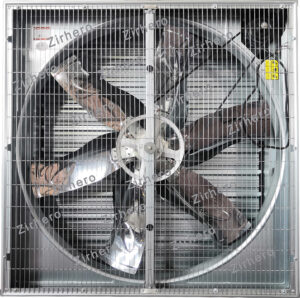
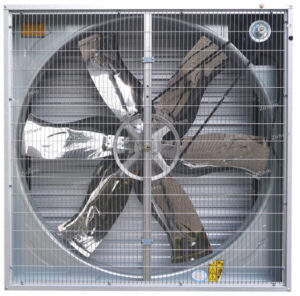
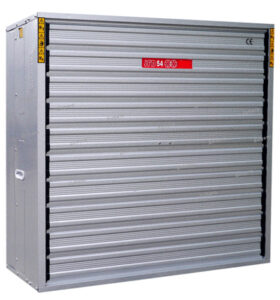
| Model | Air Volume m3/h | Blade Size mm | Drive | Blade speed (rpm) | Power (w) | Frame (mm) | Noise (dB) |
| ZF-710 | 18000 | 710 | Belt | 560 | 375 | 800*800*450 | <65 |
| ZF-750 | 24000 | 750 | Belt | 560 | 550 | 900*900*450 | <65 |
| ZF-900 | 28000 | 900 | Belt | 560 | 550 | 1000*1000*450 | <65 |
| ZF-1000 | 36000 | 1000 | Belt | 560 | 750 | 1100*1100*450 | <65 |
| ZF-1100 | 40000 | 1100 | Belt | 505 | 750 | 1220*1220*450 | <65 |
| ZF-1250 | 45800 | 1250 | Belt | 450 | 1100 | 1380*1380*450 | <65 |
| ZF-1400 | 55000 | 1400 | Belt | 380 | 1400 | 1530*1530*450 | <65 |
Temperature Control
Exhaust fans help to expel hot air that accumulates inside the greenhouse, particularly during the day when sunlight is at its peak. By removing the warm air, they help prevent overheating, ensuring the internal temperature remains within a range that is conducive to plant health.
Exhaust fans aid in the continuous movement of air within the greenhouse. Proper air circulation is essential to avoid the stagnation of hot air at the top and cool air near the ground, ensuring an even temperature distribution throughout the space.
Excess moisture in the air can lead to high humidity levels, which may cause fungal diseases or poor plant growth. Exhaust fans help regulate humidity by removing the moist air and replacing it with drier, cooler air from outside. This also helps in maintaining an ideal moisture balance for plant health.
When used in conjunction with intake fans or vents, exhaust fans can create a passive cooling system. This system reduces the need for additional cooling methods, such as air conditioning, making it more energy-efficient and cost-effective.
In greenhouses with glass or plastic coverings, heat tends to build up inside quickly. Exhaust fans help alleviate this by continuously removing the rising warm air and preventing it from accumulating near the roof, thereby avoiding hot spots within the structure.
Modern exhaust fans can be equipped with temperature and humidity sensors, allowing them to automatically adjust based on the internal conditions. This automation ensures that the temperature is always controlled efficiently without manual intervention.
By maintaining a consistent temperature and humidity level, exhaust fans contribute to healthier plants. Proper temperature control prevents stress on plants, leading to better growth, higher yields, and reduced susceptibility to pests and diseases.
Exhaust fans help in the removal of excess carbon dioxide (CO2) that builds up from plant respiration, which can otherwise harm plant growth. Proper ventilation ensures that the plants have access to the right balance of CO2 and oxygen.
By ensuring a balanced environment in terms of temperature, humidity, and airflow, exhaust fans can significantly enhance greenhouse conditions, fostering better plant growth and overall productivity.
High humidity levels can lead to mold, mildew, and fungal growth, which can harm plants and create an unhealthy environment. Exhaust fans help by expelling moist air from the greenhouse and replacing it with drier air, preventing excessive humidity buildup. This reduces the risk of plant diseases and maintains a healthier air environment.
In a closed environment like a greenhouse, air can quickly become stale, containing high levels of CO2 and other plant emissions. Exhaust fans help expel this stagnant air and bring in fresh oxygen, improving overall air quality. They also help remove volatile organic compounds (VOCs), which can be emitted by plants or materials within the greenhouse.
Plants absorb CO2 during photosynthesis, but when CO2 levels rise too high, it can hinder plant growth and even be harmful to them. Exhaust fans help maintain proper air circulation, preventing the accumulation of CO2 and ensuring that plants have the right balance of gases for optimal growth.
Odors from decaying plant matter, fertilizers, or organic waste can build up in a greenhouse environment. Exhaust fans help by removing these odors and circulating fresh air, improving air quality and making the space more comfortable for workers and visitors.
Fresh air is essential for maintaining the right oxygen levels for plants and humans in the greenhouse. By constantly circulating the air, exhaust fans ensure that oxygen levels remain consistent, which is crucial for plant respiration and a healthy atmosphere overall.
By removing humid, stagnant air, exhaust fans help prevent conditions that are favorable for pests and diseases to thrive. Clean, fresh air reduces the chances of harmful insects, fungi, or bacteria from settling in the greenhouse and damaging plants.
In addition to air quality, exhaust fans contribute to maintaining a stable temperature. Consistent temperatures help plants thrive and reduce stress that can lead to poor growth or plant susceptibility to diseases. A balanced temperature also supports air quality by preventing the buildup of heat that can exacerbate humidity and poor airflow.
In commercial greenhouse operations, maintaining proper ventilation is often necessary to meet health and safety standards. Exhaust fans can help maintain compliance by ensuring the air quality remains within acceptable ranges for workers and plants, reducing the risk of harmful air conditions.
Excess moisture in the air creates a favorable environment for fungal growth. Exhaust fans help reduce this moisture, lowering the risk of fungal diseases like powdery mildew and root rot that can damage plants and contaminate the greenhouse air.
In short, exhaust fans are essential for ensuring that the air inside a greenhouse remains fresh, clean, and conducive to healthy plant growth. They improve the overall air quality by managing humidity, CO2 levels, temperature, and ventilation, creating an optimal environment for both plants and workers.
They work as part of a passive cooling system, helping to maintain a comfortable temperature inside the greenhouse without relying on electric-powered cooling systems. By continuously expelling hot air, they allow cooler air to enter, which reduces the need for additional cooling, like air conditioning or misting systems. This can significantly cut energy costs during hot weather.
When exhaust fans are used in conjunction with intake vents or windows, they create a natural airflow that helps regulate temperature and humidity levels inside the greenhouse. This reduces the need for artificial ventilation systems, which consume more electricity and add to operating costs.
In colder months, maintaining a consistent temperature is important, but heating systems can be energy-draining. Exhaust fans help by ensuring that hot air doesn’t accumulate at the top of the greenhouse, where it would be wasted. With proper ventilation, the greenhouse environment can be maintained more efficiently, reducing the need for excessive heating.
During the summer or on particularly sunny days, greenhouses can easily overheat. Without proper ventilation, the temperature can rise to levels that damage plants. Exhaust fans prevent overheating by expelling the hot air, keeping the greenhouse temperature under control without relying on air conditioners or cooling systems, which consume significant amounts of energy.
When paired with automated temperature and humidity controls, exhaust fans can help fine-tune the greenhouse environment. If the system detects that it’s too warm, it can activate the fans to cool the space down without needing to run the heating or cooling systems for long periods. This helps to maintain a stable climate in a more energy-efficient way.
Exhaust fans are relatively low-energy devices compared to other climate control equipment. By relying on natural airflow (wind and temperature differences between the outside and inside), exhaust fans use less energy to improve conditions, reducing the overall energy consumption of the greenhouse.
Many modern exhaust fans are automated and can adjust based on real-time environmental conditions. This means that the fans only operate when needed, preventing unnecessary energy consumption. For example, they’ll only run when the temperature reaches a threshold or when humidity levels become too high, ensuring they’re not wasting power when the conditions are already ideal.
In some advanced greenhouse setups, exhaust fans can be integrated with heat recovery systems. These systems capture and reuse the heat from the exhaust air to warm the incoming air, reducing the energy required to heat the greenhouse. This is particularly useful in cooler climates, where maintaining temperature is essential, but energy-efficient heat recovery is needed to minimize consumption.
While exhaust fans require an upfront investment, their ability to reduce reliance on other, more energy-intensive systems means they can pay for themselves over time. By reducing cooling and heating costs, they make greenhouses more sustainable and cost-effective in the long run.
Exhaust fans generally require less maintenance than other cooling or heating systems. With fewer moving parts and less reliance on expensive components, the overall maintenance costs tend to be lower, adding another layer of efficiency to greenhouse operations.
In summary, exhaust fans improve energy efficiency by creating a natural cooling effect, reducing the need for additional mechanical systems, and optimizing climate control. They also help to lower overall operational costs and energy consumption, making them a smart choice for any energy-conscious greenhouse owner.
Exhaust fans help regulate temperature by removing excess heat and ensuring that the greenhouse environment remains within the ideal range for plant growth. This consistency is critical for plant health, as temperature fluctuations can cause stress, stunt growth, or even damage plants. With a more stable environment, plants grow more uniformly and efficiently, boosting overall productivity.
Proper air circulation is essential for preventing stagnant air pockets and promoting healthy plant growth. Exhaust fans help distribute air evenly throughout the greenhouse, preventing hot spots, moisture buildup, or areas where air is too humid. This allows plants to access the right amount of CO2, oxygen, and other gases, leading to better photosynthesis and faster growth.
Excess moisture and stagnant air provide a breeding ground for mold, mildew, and other fungal diseases that can harm plants. Exhaust fans help reduce excess humidity, keeping the air inside the greenhouse dry enough to prevent these problems. This lowers the likelihood of diseases spreading, which can otherwise reduce plant health and yield. Healthy plants are more productive, meaning more growth and better overall results.
Exhaust fans help maintain the right balance of gases inside the greenhouse. By removing excess CO2 and ensuring fresh air comes in, they help maintain optimal levels of CO2 for plant photosynthesis. This is essential for maximizing plant growth rates. Plants that can photosynthesize effectively grow faster, leading to greater productivity in terms of both quantity and quality of crops.
Excessive heat, humidity, and poor airflow can cause plant stress, which slows growth and reduces yields. By maintaining an optimal environment through the continuous operation of exhaust fans, plants experience less stress and grow more vigorously. Reduced stress leads to healthier plants, which in turn improves overall productivity and crop output.
Good airflow in a greenhouse can also help with the distribution of pollen. When plants are properly ventilated, they are more likely to have healthy, active flowers that promote better pollination. This is particularly beneficial for crops that rely on wind or air to move pollen. Improved pollination results in higher yields and better fruit or flower production.
As mentioned earlier, they help reduce the need for additional heating and cooling systems. With lower energy costs and optimized conditions, greenhouses can allocate resources more effectively toward plant care, such as watering, fertilization, and pest control. This focus on plant health leads to enhanced growth rates and better productivity.
In climates where temperatures fluctuate widely, exhaust fans can help regulate the internal environment of a greenhouse, extending the growing season. By keeping temperatures within the optimal range, plants can grow more consistently throughout the year, leading to more harvests or a higher turnover of crops.
A controlled and well-ventilated greenhouse environment ensures that plants are less vulnerable to environmental factors like extreme heat, humidity, or disease outbreaks. This stability reduces the risk of crop loss, ensuring that the time, effort, and resources invested in cultivation lead to greater yields.
Exhaust fans also contribute to a better working environment for greenhouse staff. By improving air quality, reducing heat stress, and ensuring more consistent temperatures, workers are able to perform tasks more efficiently. When workers are more comfortable and the greenhouse conditions are optimal, they can spend more time focusing on plant care, which further boosts productivity.
Excessive heat can reduce the amount of natural light entering the greenhouse, as glass or plastic may become fogged or clouded. By controlling the temperature and humidity, exhaust fans help maintain clear coverings, allowing more sunlight to reach the plants. More light improves photosynthesis, leading to healthier plants and faster growth.
In summary,they enhance productivity by optimizing temperature, air circulation, humidity, and CO2 levels—all of which are essential for plant health and efficient growth. By reducing stress, preventing disease, and improving the overall growing environment, exhaust fans help plants grow more quickly and yield better results. Additionally, the cost savings from energy efficiency and the long-term health of the plants contribute to a more productive and sustainable greenhouse operation.
Exhaust fans help regulate temperature and humidity naturally, reducing the need for additional cooling and heating systems that consume significant amounts of energy. During hot weather, they provide passive cooling by expelling hot air, preventing the need for air conditioning. In cooler months, they help prevent heat buildup that could make heating systems work harder. With energy-efficient exhaust fans, greenhouses can maintain optimal conditions without excessive energy use.
Air conditioning systems are energy-intensive and can significantly increase operating costs in a greenhouse, especially in hot climates. Exhaust fans help reduce the dependency on air conditioning by providing natural ventilation, keeping the internal temperature cooler without the need for electrically powered cooling. This translates to lower electricity bills and overall energy savings.
High humidity levels inside a greenhouse can lead to problems like mold, mildew, and fungal growth. Dehumidifiers are often used to control excess moisture, but they can be costly to run and maintain. Exhaust fans work to remove humid air, helping to reduce the moisture level naturally and thereby decreasing the need for dehumidifiers and their associated energy costs.
During colder months, they help maintain an even temperature by removing excess hot air that may gather at the top of the greenhouse. By preventing heat from accumulating unnecessarily, exhaust fans ensure that heating systems don’t have to work as hard to maintain the desired temperature. This reduces the overall energy required for heating and helps lower heating costs.
Exhaust fans typically require less maintenance than more complex climate control systems like HVAC units, air conditioners, or humidifiers. Fewer moving parts and less reliance on high-maintenance equipment mean lower repair and replacement costs. This helps to reduce overall operational costs over the long term.
By maintaining optimal environmental conditions, exhaust fans help plants grow more efficiently, leading to higher yields. With better plant health and reduced loss due to disease or stress, growers can see a better return on investment without needing to invest heavily in additional climate control systems. This means more efficient use of resources and a higher output for less expense.
Excess humidity, poor airflow, and heat buildup can create an ideal environment for pests and diseases. By controlling humidity and improving airflow, exhaust fans help reduce the occurrence of pest infestations and fungal outbreaks. This can reduce the need for costly pest control measures, such as pesticides, which can be expensive and labor-intensive to apply.
By ensuring that the greenhouse environment stays at optimal levels, exhaust fans help to prevent plant damage caused by overheating, humidity imbalances, or poor air quality. The reduction in crop loss translates to fewer financial losses from wasted resources, seeds, and plants. Healthy plants mean more successful harvests and reduced costs from crop failure.
A stable and healthy growing environment reduces the need for constant monitoring and intervention. Since exhaust fans help automate the ventilation process and maintain optimal conditions, workers spend less time managing temperature, humidity, and airflow. This can lead to a reduction in labor costs, as employees can focus on higher-priority tasks, such as plant care or harvesting.
Exhaust fans are an environmentally friendly way to maintain the internal climate of a greenhouse. By reducing the need for energy-intensive systems, they lower the carbon footprint and contribute to sustainable farming practices. As sustainable practices are often incentivized through government grants or subsidies, greenhouse owners may benefit from additional financial support.
Excess humidity can result in condensation that leads to water wastage or overwatering. With exhaust fans maintaining a balanced humidity level, water use can be more efficiently managed. This prevents waterlogging and reduces the costs associated with over-watering systems, water treatment, and waste.
Since Exhaust fans are relatively inexpensive to install compared to full-scale HVAC systems, they provide a cost-effective way to manage greenhouse environments. This reduces the need for substantial capital investment in larger, more complex equipment, which is especially beneficial for small to medium-sized operations.
In conclusion, exhaust fans offer a variety of cost-saving benefits, from lowering energy bills to reducing the need for expensive equipment, labor, and pest control. They help create a more efficient, productive, and sustainable greenhouse environment while keeping operational costs down.
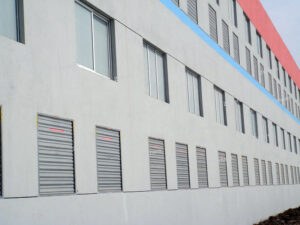
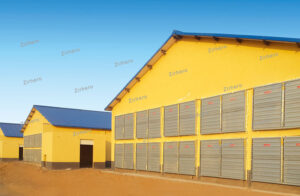
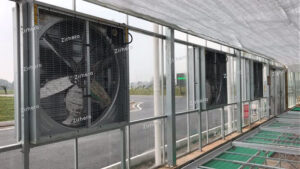
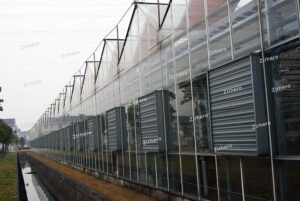
We will contact you within 1 working day, please pay attention to the email with address “[email protected]”.